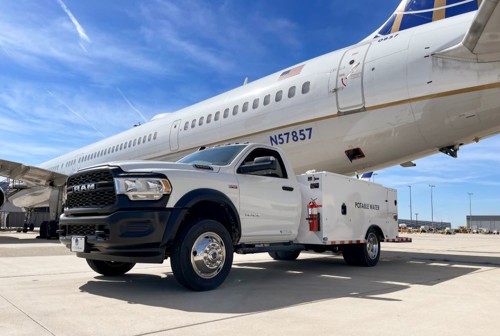
Picture credit: Vestergaard
When countries started lifting Covid-era restrictions from the end of 2021 and early 2022, airlines eagerly ramped up passenger services, which meant many were looking at their GSE fleet and upgrading equipment.
A year on from China lifting its travel restrictions, passenger traffic is back at pre-Covid levels and exceeding it in places.
Gul Denge, Sales Director at DENGE Airport Equipment said demand in 2023 was noticeably higher than 2022, saying: “The demand surge in 2023 can largely be attributed to the rebounding passenger traffic in the aviation industry. As travel restrictions eased and the aviation sector began to recover, there was a heightened need for our water supply trucks and vacuum lavatory trucks to support ground operations at airports worldwide.”
At Vestergaard, strong demand for all of its products meant turnover was much higher in 2023 than 2022.
Jan Pojezny, Technical Sales Manager, said: “We had just invested in a substantially expanded production capacity, which was completed during 2020, so this rebound was particularly welcomed by Vestergaard.”
Deicers are the product Vestergaard is best known for, but water and toilet service units are a growing part of the business with different products serving different aircraft and ground operations.
Across its range, electric GSE is increasingly popular, now making up over 40% of sales.
Stinar delivered over a dozen trucks and shipped several carts.
Craig Kruckeberg, CEO of Kruckeberg Industries, said: “Our only limit to production output was OEM chassis availability. We’re fully stocked and ready to start 2024 off on the right foot though, we’ve many OEM chassis and types on our lot ready for the next customer.”
Based in Thailand, Simone Livraghi, Senior Sales Manager of Panus Assembly noted an upswing in 2022 which intensified in 2023.
Storing vehicles during the pandemic created complexity, said Livraghi, saying that putting the vehicles back into service sometimes was more expensive than acquiring a new vehicle.
He said: “Looking ahead to 2024, we anticipate a sustained demand in the industry, particularly in the Asian market. Our expansion into the United Kingdom and other countries is being facilitated by the option to source right-hand drive (RHD) chassis from Thailand. We also provide diverse options, including both diesel and electric models with tanks of varying capacities.”
Entering 2024, expectations for the year are high with Kruckeberg saying: “We have seen a tremendous pick up since things have gotten back to normal, as has the industry as a whole and only continually see positive impact going forward.”
Timsan has been manufacturing water and toilet service vehicles since 1986 and has made 178 of the former and 218 of the latter.
Haldun Aksoy, Chairman of the Board expects a challenging year in 2024 though demand should be more stable and higher than last year.
He said: “Demand is very intense in the Turkish market and the European region in 2024, as in 2023. As the number of aircraft, flights, new airports and passengers increase, the demand for these vehicles will continue to increase every year.”
Denge added: “As the aviation industry continues to recover and adapt to changing travel patterns and environmental regulations, we expect sustained demand for our products. We also plan to explore opportunities for innovation and expansion to meet the evolving needs of our customers.”
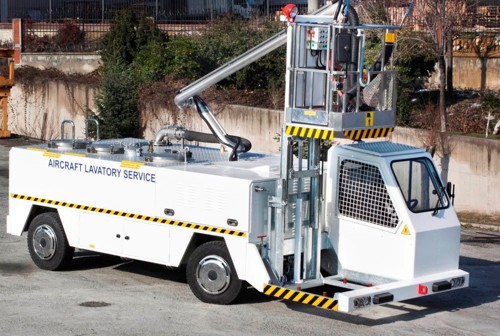
Different customer needs
Stinar receives requests from FBOs, ground handlers, airports, commissions, private charters, leasing/rental companies, commercial airlines, military branches and overseas clients.
Kruckeberg said: “All are different, but needs are similar in servicing aircraft with potable water. Carts and chassis-mounted units vary depending on the size of the operations and plane type.”
Government and military airports have a greater need for smaller vehicles.
Andre Schön, Sales Manager at Schrader, said: “Due to the tense global situation, these institutions are investing in new and reliable equipment. Due to price pressure and lower handling numbers, regional airports are also tending towards smaller vehicles and trailer solutions, which are economically interesting to procure and maintain.”
Large units are of greater interest for large airports and hubs where the number and size of aircraft determines the choice of vehicle, added Schön.
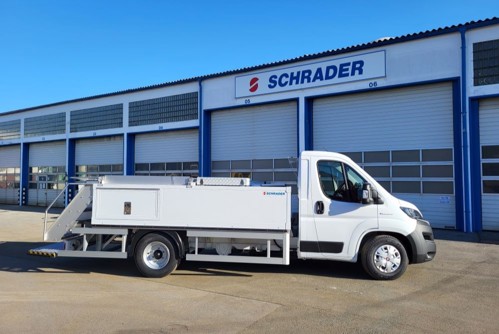
Dependable equipment
Efficiency, safety, durability and compliance with industry standards are some of the main design considerations for water and toilet service trucks, explains Denge.
“These vehicles must be designed to efficiently transport and dispense water or manage wastewater while ensuring the safety of operators and the environment. Durability is crucial to withstand the demanding conditions at airports, and compliance with industry regulations is non-negotiable to meet the highest standards of sanitation and hygiene,” she said.
The DENGE lavatory truck is equipped with an internal vacuum generation system, which Denge explains is designed to create and maintain vacuum pressure within the tank itself rather than relying on external vacuum extraction.
She explained the advantage of generating vacuum within the tank is it offers a consistent and dependable suction force, reducing the risk of interruptions or performance interruption.
“Compared to external vacuum extraction methods, which may require additional energy for the extraction process, our system is designed to be more energy-efficient, resulting in cost savings for operators,” she said.
Other benefits of DENGE’s equipment are shorter service times and improved sanitation due to vacuum generation taking place in the tank, reducing the risk of contaminants entering the system through external hoses or connections.
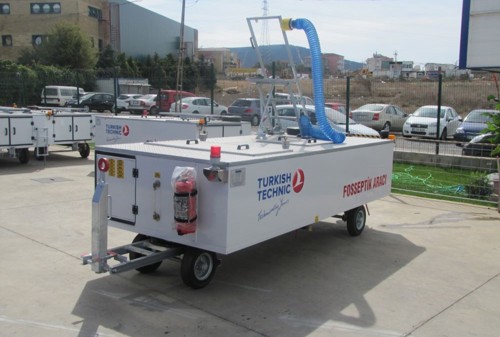
Equipment needs to be safe and efficient, said Aksoy, with safety features including emergency shut-off valves and overflow protection, systems to prevent cross-contamination between potable water and lavatory waste, and they must feature environmental measures for the correct recycling, treatment and disposal of waste water.
The vehicles also need to be compatible with airport infrastructure, be mobile and manoeuvrable, have adequate capacity and volume, have reliable pumping systems and filtration and treatment.
Aksoy also pointed out that vehicles need the right weight distribution so they are safe and stable to operate, they need to be easy to use and control, and they need to be easy to maintain with access to spare parts.
Aksoy added: “It’s crucial to stay informed about industry advancements and technological innovations to continuously improve the design of these essential GSE.”
Panus wants to make equipment easy to use and maintain, with Livraghi saying: “Our philosophy prioritises simplicity, eschewing complex electronics, and ensuring user-friendliness and ease of maintenance. We utilise components readily available in the common spare parts market.”
Commercial chassis is more cost-effective to maintain in the long-term compared to products produced in-house.
He said: “This is due to the one-way channel for spare parts supply, whereas commercial vehicles benefit from an open market for alternative sources.”
Stinar’s units are based on an OEM cab/chassis so when customers purchase a chassis, it has parts, servicing and a dealer network available nationwide, said Kruckeberg.
“It’s not only backed by our Stinar unit warranty but the OEM warranty as well. Ground service is a tough industry that has little margin for error, we deliver a unit that is going to do the job the customer expects the unit to do, time after time,” he said.
Schrader is working on a new, economical tank concept, which Schön said will make it possible to transport larger quantities of smaller payloads.
He explained: “An important reason for this new design is the range consideration for fully electric vehicles, where longer operating times can be achieved thanks to lower body weights.”
Tank truck manufacturing is Schrader’s area of expertise, which Schön said results in high quality and durability for water and toilet vehicles.
“Thanks to our decades in this area, we have always faced the requirements of the market and our customers and can supply our vehicles with options for all latitudes. These include, for example, frost protection for extreme conditions, data tracking or solutions for employee protection,” he said.
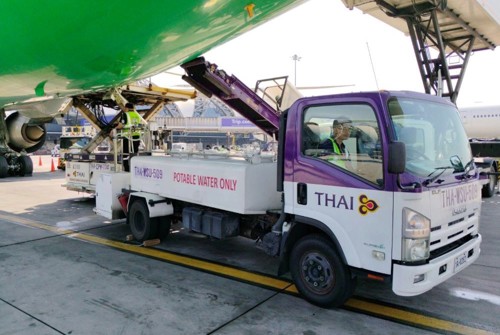
Ready for the future
Manufacturers are offering electric powertrains due to demand to decarbonise ground operations.
Ever since Vestergaard launched its eVTS and eWS units in 2019, interest has been high, not just because of their sustainable performance but also for driver visibility and access due to being able to design and build the product from scratch.
Electric powertrains are the obvious alternative to internal combustion engines but Vestergaard is also looking at other power sources including hydrogen.
Most electric rivals are not practical due to a lack of infrastructure, admits Pojezny, commenting: “Electric power, however, is readily available at most airport locations and where not, efforts are often made towards further electrification, with additional recharging facilities being established.”
Electric powertrains are not suitable everywhere so there is still a place for diesel-powered vehicles.
Panus offers conversion kits for customers interested in transitioning from diesel to electric.
Livraghi said: “In Asia, the sustained high demand for diesel is attributed to the lack of charging infrastructure in airports and airside areas, coupled with the challenges posed by various charging protocols (CCS2, GB-T, CHADEMO) that complicate matters for manufacturers.”
Pojezny says that units based on a diesel chassis are being electrified with for functions such as running water and vacuum pumps because electric motors offer advantages including being easier to maintain than hydraulic systems.
Hybrids are considered to be an interim solution by many, according to Pojezny, who says the different solutions make it hard for workshops to stay up to date.
Also, because operations can continue even when voltage is low, some operators do not recharge the unit so do not take advantage of electric power.
Aksoy sees future developments focusing on lightweight and durable materials, automation and robotics for tasks such as cleaning, maintenance and monitoring to reduce manual intervention, health and safety with touchless systems, antimicrobial surfaces and advanced sanitation, improved energy efficiency and alternative power sources, and equipment will need to adapt to changing regulations and standards for water quality, waste disposal and environmental sustainability.
Denge said advances have been made in technology and sustainability with automation, monitoring systems and battery powertrains becoming commonplace.
She sees further innovation in these areas with a focus on energy efficiency, reduced emissions and smart technologies to improve operational efficiency and environmental performance.
Change can be hard, admitted Kruckeberg but sometimes it is necessary. Stinar went through a change of ownership a few years ago, creating a new Stinar with new design and build processes.
Time has been spent researching the GSE market to make the units more appealing, not just for buyers but users and mechanics.
Kruckeberg said: “Our future is bright, we’re well underway on new designs, alternative fuel types, and different design and component integration that will keep our units at the forefront of the GSE industry.”
This article was published in the February 2024 issue of Ground Handling International, click here to read the digital edition and click here to subscribe.
